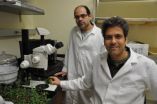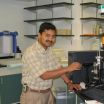(Press-News.org) (Chicago, IL) - Location and other geographical factors play an important role in supporting economic growth and development in emerging markets, a new study from the Consortium on Financial Systems and Poverty has found.
The study, which examines growth in the Thai economy between 1986 and 1996, shows that a high concentration of enterprise in an area predicts high subsequent growth in and around that area. Entrepreneurial activity decreases virtually by the mile the further away one gets from centers of economic concentration.
In addition, other geographic conditions, such as flat topography and proximity to transportation, also show a strong correlation to enterprise growth.
These are the findings presented by Robert M. Townsend and John S. Felkner in a article in the current issue of Quarterly Journal of Economics, "The Geographic Concentration of Enterprise in Developing Countries."
Townsend, a professor of economics at the Massachusetts Institute of Technology and principal investigator of CFSP, and Felkner, a research scientist at the University of Chicago's National Opinion Research Center, used extensive economic and physiographic data down to the village level in Thailand. Their conclusions are drawn from an economic model that was tested against actual developments over time.
Thailand, the subject of intensive research by Townsend, is largely considered an Asian success story. It has shown consistently strong growth despite military coups, tsunamis, and the Asian financial crisis.
In the 10-year period studied, village wealth doubled, and by 1992 the ratio of money-like-assets to GDP, which indicates the level of financial intermediation, exceeded the level in the United States. At the same time, the country industrialized, with the fraction of GDP in manufacturing rising from 23 to 35% and the number of households in non-farm enterprises increasing by 27%.
However, this growth is not taking place uniformly throughout the country. Among the key findings of the study, which may suggest insights to other developing countries, are:
There are high concentrations of enterprise around the capital of Bangkok and along main transportation arteries running north. At the rural village level, concentrations of enterprise within each province center surrounding large towns and intersections of major highways.
Levels of enterprise drop as the distance to market and infrastructure grows.
Over time, areas of high concentrations of enterprise (and those nearby) show increasing levels of enterprise. This suggests that enterprise fosters more enterprise.
At the national level, there is some dissipation of large, central core concentrations of enterprise. In rural areas, the patterns are more mixed, but show little dissipation.
Numerous regions remain stagnant. From the perspective of the national scale, some regions appear to be permanently lagging, such as the Northeast, and other areas appear to have both low levels of enterprise and low growth.
In rural areas, growth in enterprise is related to favorable environmental conditions such as good soil, proximity to rivers, and flat topography.
"We think these findings are important because we establish that concentrations of enterprise across space in a developing country play a crucial role in the larger process of development," notes Townsend.
"This could have important implications for developing economies, particularly for financial intermediaries, transportation planning, and industrial organization."
###
Robert M. Townsend is the Elizabeth and James Killian Professor of Economics in the Department of Economics at MIT. Prior to that, Townsend was the Charles E. Merriam Distinguished Service Professor in the Department of Economics at the University of Chicago, where he remains a Research Associate. Since 1997, Townsend has undertaken large scale village surveys in Thailand to analyze the interaction between household decisions and community behavior at different levels of aggregation including families, villages, regions, and country-wide. John S. Felkner is a research scientist at the National Opinion Research Center, University of Chicago.
The Consortium on Financial Systems and Poverty (CFSP) is a research organization comprised of leading and emerging economists. Their goal is to improve the lives of the world's poor and to reduce poverty through helping to identify, design, and implement more efficient financial systems.
Location, location, location: Economists document key role of spatial component in economic growth
2011-12-19
ELSE PRESS RELEASES FROM THIS DATE:
NIH scientists find a potential new avenue for cancer therapies
2011-12-19
Recent findings in mice suggest that blocking the production of small molecules produced in the body, known as epoxyeicosatrienoic acids (EETs), may represent a novel strategy for treating cancer by eliminating the blood vessels that feed cancer tumors. This research is the first to show that EETs work in concert with vascular endothelial growth factor (VEGF), a protein known to induce blood vessel growth. Together, EETs and VEGF promote metastasis, or the spread of cancer, by encouraging the growth of blood vessels that supply nutrients to cancer cells.
The research ...
Aggressively Pursuing the Compensation Brooklyn Scaffolding Accident Victims Deserve
2011-12-19
Brooklyn has seen more than its fair share of construction projects in recent years. While the scope of these developments varies in size from small restoration and maintenance projects costing only thousands of dollars to the multibillion-dollar Atlantic Yards project in Prospect Heights, they all involve the potential for scaffolding accidents or ladder falls that may cause serious injury to those working on site.
At Simon Eisenberg & Baum, our Brooklyn construction accident lawyers help injured construction workers and families obtain compensation for damages ...
Acupuncture reduces protein linked to stress in first of its kind animal study
2011-12-19
Washington, DC — Acupuncture significantly reduces levels of a protein in rats linked to chronic stress, researchers at Georgetown University Medical Center (GUMC) have found. They say their animal study may help explain the sense of well-being that many people receive from this ancient Chinese therapy.
Published online in December in Experimental Biology and Medicine, the researchers say that if their findings are replicated in human studies, acupuncture would offer a proven therapy for stress, which is often difficult to treat.
"It has long been thought that acupuncture ...
San Diego Zoo researchers contribute to project using mummy DNA to differentiate croc species
2011-12-19
The Nile crocodile is a species that was identified by ancient Egyptians. Genetic analysis done by a group of geneticists using samples taken from species throughout the animal's range and including DNA from mummified crocodile remains indicates that more than one species is known by this name.
"This paper provides a remarkable surprise: the Nile crocodile is not a single species, as previously thought, but instead demonstrates two species - living side-by side - constitute what has been called the Nile croc." Said Marlys Houck, geneticist with San Diego Zoo Global's ...
Elves Pull Off Daring Rescue Of Santa Claus And Reindeer
2011-12-19
It started out like any other Christmas Eve, but before the night was over, things would never be the same for Santa Claus and the reindeer. For the first time, the story of the Elves daring rescue of Santa Claus is revealed on a new free website, The Santa Claus Sleigh.
For years the number of good little girls and boys had been growing and growing, so the number of toys to deliver was through the roof. But Santa Claus was still using the same little red sleigh to deliver the toys. So every year, it took more and more trips back to the North Pole to reload the sleigh. ...
A major step forward towards drought tolerance in crops
2011-12-19
RIVERSIDE, Calif. – When a plant encounters drought, it does its best to cope with this stress by activating a set of protein molecules called receptors. These receptors, once activated, turn on processes that help the plant survive the stress.
A team of plant cell biologists has discovered how to rewire this cellular machinery to heighten the plants' stress response – a finding that can be used to engineer crops to give them a better shot at surviving and displaying increased yield under drought conditions.
The discovery, made in the laboratory of Sean Cutler, an ...
Study: African-American men don't reap same career benefits from mentoring as Caucasians
2011-12-19
Athens, Ga. – Networking within an organization and having a mentor are widely thought to promote career success, but a new University of Georgia study finds that African-American men don't receive the same measurable benefits from these professional connections that Caucasians do.
Study co-author Lillian Eby, a professor in the Industrial-Organizational Psychology Program in the UGA Franklin College of Arts and Sciences, said the finding shouldn't discourage African Americans from seeking mentoring and networking opportunities. Rather, it emphasizes the need for women ...
Grafting of human spinal stem cells into ALS rats best with immunosuppressant combination
2011-12-19
Tampa, Fla. (Dec, 19 2011) – A team of researchers grafting human spinal stem cells into rats modeled with amyotrophic lateral sclerosis (ALS), also known as "Lou Gehrig's Disease," a degenerative, lethal, neuromuscular disease, have tested four different immunosuppressive protocols aimed at determining which regimen improved long-term therapeutic effects. Their study demonstrated that a combined, systematically delivered immunosuppression regimen of two drugs significantly improved the survival of the human spinal stem cells. Their results are published in the current ...
UCF nanotechnology may speed up drug testing
2011-12-19
Testing the effectiveness of new pharmaceuticals may get faster thanks to a new technique incorporating quantum dots developed at the University of Central Florida.
Some drug testing can take a decade or more, but UCF associate professor Swadeshmukul Santra and his team have created an electronic quantum dots (Qdots) probe that "lights up" when a drug it is delivering attaches to cancer cells. The research appears online in this month's Biomaterials. http://www.sciencedirect.com/science/article/pii/S0142961211012841#FCANote
A researcher can use a microscope to see ...
Bone marrow-derived cells differentiate in the brain through mechanisms of plasticity
2011-12-19
Tampa, Fla. (Dec, 19 2011) – Bone marrow-derived stem cells (BMDCs) have been recognized as a source for transplantation because they can contribute to different cell populations in a variety of organs under both normal and pathological conditions. Many BMDC studies have been aimed at repairing damaged brain tissue or helping to restore lost neural function, with much research focused on BMDC transplants to the cerebellum at the back of the brain. In a recent study, a research team from Spain has found that BMDCs, can contribute to a variety of neural cell types in other ...


